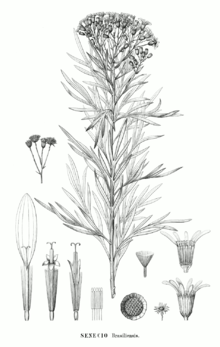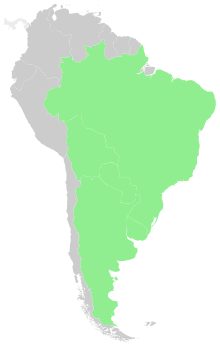Senecio brasiliensis
| Senecio brasiliensis | |
|---|---|
 | |
| flor-das-almas | |
| Scientific classification | |
| Kingdom: | Plantae |
| (unranked): | Angiosperms |
| (unranked): | Eudicots |
| (unranked): | Asterids |
| Order: | Asterales |
| Family: | Asteraceae |
| Tribe: | Senecioneae |
| Genus: | Senecio |
| Species: | S. brasiliensis |
| Binomial name | |
| Senecio brasiliensis (Spreng.) Less. | |
 | |
| Native range of S. brasiliensis. | |
| Synonyms | |
|
Cineraria brasiliensis Spreng.[1] | |
Senecio brasiliensis or by its common name flor-das-almas,[1] (flower-of-souls) a perennial species of Senecio genus and the family Asteraceae grows as a native in the fields and meadows of central South America.
Description
S. brasiliensis is a densely leafy perennial herb, 1 metre (3.3 ft) to 2 metres (6.6 ft) tall, with yellow flowers that prefers to make its home in degraded pasture lands and unploughed croplands in central South America.[3][4]
Leaves and stems: S. brasiliensis stands very upright with a branched hairless and grooved stem. The leaves are alternate, pinnate and deeply lobed[4] dark green on the top, whitish green on the underside.[5] The lower part of the plant is smooth, while the upper part is hairy and the leaves cluster at the highest point with the flower stalks (corymbs).[4]
Flowers: Yellow flowers dense on corymbs; two types of flowers (that look like [petal]s), disc florets with both male and female flowers and ray flowers which are simply female.[4]
Seeds: Small seed with white hairs that use the wind to get around with.[4]
Common Names
- English: Flower of souls, hempleaf ragwort
- Portuguese: malmequer-amarelo, Maria-mole, tasneirinha, flor-das-almas[1][4][5][6]
 growing in Rio Grande do Sul
growing in Rio Grande do Sul
Distribution
S. brasiliensis grows at elevations of 0 metres (0 ft) to 1,000 metres (3,300 ft).
Native: Argentina (mostly North Argentine Northwest and Gran Chaco), Bolivia, Brazil (mostly South Central), Paraguay, and Uruguay.[1][2][4][6]
Current:
- America
Predators
- Phaedon confinis (Chrysomelidae)[3]
- Atarsocoris brachiariae (Hemiptera: Cydnidae) -- Burrowing brown bug[7]
References
- 1 2 3 4 Germplasm Resources Information Network (GRIN) (1998-09-03). "Taxon: Senecio brasiliensis (Spreng.) Less.". Taxonomy for Plants. USDA, ARS, National Genetic Resources Program, National Germplasm Resources Laboratory, Beltsville, Maryland. Retrieved 2008-03-05.
- 1 2 Instituto Darwinion. "Asteraceae" (PDF). Catálogo de las Plantas Vasculares de la República Argentina. II (in Spanish). Universidad de Buenos Aires. pp. 184, 188. Retrieved 2008-03-05.
- 1 2 Michelli Maria Mendes; Maysa de Lima Leite; Geovan Henrique Corrêa; Julianne Milléo (2005-04-20). "ENTOMOFAUNA ASSOCIATED WITH SENECIO BRASILIENSIS LESS (ASTERACEAE), AND PHAEDON CONFINIS (INSECTA; COLEOPTERA; CHRYSOMELIDAE) AS A POSSIBLE CONTROLLER AGENT OF THIS TOXIC PLANT" (PDF) (in Portuguese). Retrieved 2008-03-05.
Phaedon confinis Klug, 1829 (Chrysomelidae) was the one that most stood out, specially because it was found in great numbers on the plant
- 1 2 3 4 5 6 7 Claudio Barros; Elissa Totin; Raquel Rech; Marcia Ilha; Steve Valeika (March 2001). "Senecio spp.". Lista de Plantas (in Portuguese). Universidade Federal de Santa Maria. Archived from the original on 21 February 2008. Retrieved 2008-03-05.
- 1 2 Centro de Informação Toxicológica do Rio Grande do Sul. "Senecio brasiliensis Less. - Maria-mole" (in Portuguese). Retrieved 2008-03-06.
- 1 2 3 Natural Resources Conservation Service (NRCS). "PLANTS Profile, Senecio cannabinifolius Hook. & Arn.". The PLANTS Database. United States Department of Agriculture,. Retrieved 2008-03-06.
- ↑ Oliveira Émerson D.M. de, Pasini Amarildo, Fonseca Inês C.B., ÉMerson D.M. de; Pasini, Amarildo; Fonseca, Inês C.B. (January 2003). "Association of the soil bug Atarsocoris sp. (Hemiptera: Cydnidae) with the weed Senecio brasiliensis Less". Neotropical Entomology. Sociedade Entomológica do Brasil. 32 (1): 155–157. doi:10.1590/S1519-566X2003000100024. 1519566X. Retrieved 2008-03-05.
External links
![]() Media related to Senecio brasiliensis at Wikimedia Commons
Media related to Senecio brasiliensis at Wikimedia Commons
![]() Data related to Senecio brasiliensis at Wikispecies
Data related to Senecio brasiliensis at Wikispecies
- "Senecio cannabinifolius". Integrated Taxonomic Information System. Retrieved 6 March 2008.
- "Herbarium record". Neotropical Herbarium Specimens. fieldmuseum.org. Retrieved 2008-04-22.
- Gustavo H. Shimizu (2006-09-30). "Image of Senecio brasiliensis". Retrieved 2008-03-06.